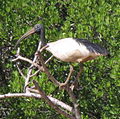| Threskiornis | |
|---|---|
 | |
| Australian white ibis, Darling Harbour, Sydney | |
| Scientific classification | |
| Kingdom: | Animalia |
| Phylum: | Chordata |
| Class: | Aves |
| Order: | Pelecaniformes |
| Family: | Threskiornithidae |
| Subfamily: | Threskiornithinae |
| Genus: | Threskiornis G.R. Gray, 1842 |
| Type species | |
| Tantalus aethiopicus Latham, 1790 | |
| Species | |
T. aethiopicus Contents | |
Threskiornis is a genus of ibises, wading birds of the family Threskiornithidae. They occur in the warmer parts of the Old World in southern Asia, Australasia and Sub-Saharan Africa. They are colonial breeders, which build a stick nest in a tree or bush and lay two to four eggs. They occur in marshy wetlands and feed on various fish, frogs, crustaceans and insects. In English, they are called sacred ibises. In Australia, urban dwelling ibises are known colloquially as "bin chickens".







